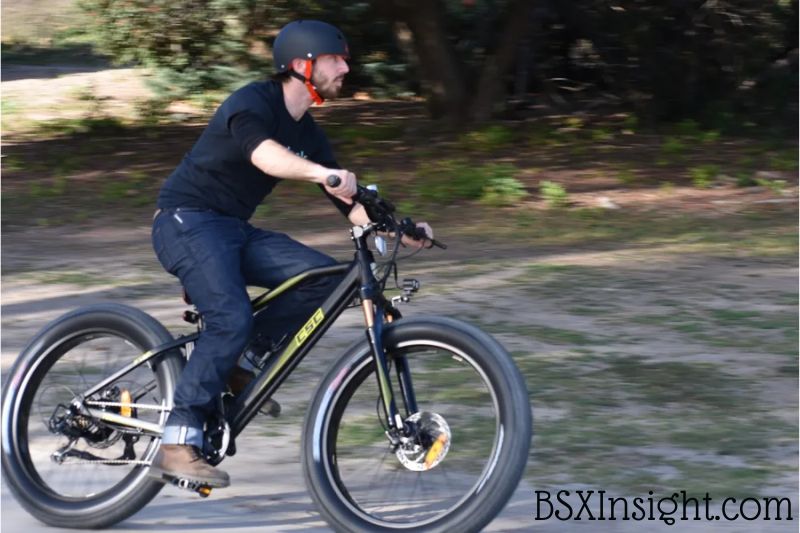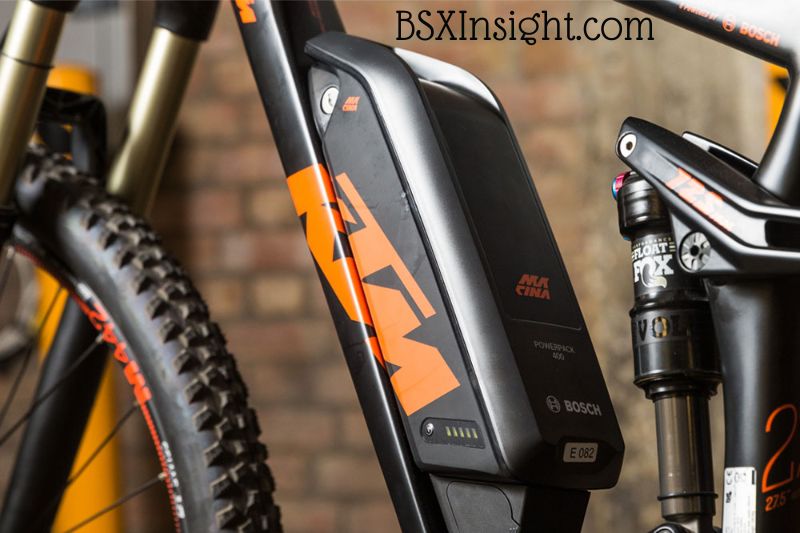Electric bikes are becoming increasingly popular, but there are some drawbacks to them. They can be expensive, and the battery life can be short, meaning that you may have to pedal more than you would with a regular bike. They also can’t be used in all weather conditions, so you may have to take them off the road when it’s raining or snowing.
Let’s be with BSXInsight to answer the question “why E Bikes are bad?” and how to avoid their dangers.
Electric Bikes and Speed
The majority of electric bikes are swift, or at least quicker than conventional pedaling. However, a surprising number of studies indicate that the average speed differences between Class 1 Ebikes and conventional bikes are not as great as I initially believed.
Generally speaking, in an urban setting, Class 1 Electric bikes are around 3 km/hr (1.9 mph) faster than conventional cycles. Class 3 electric bikes were discovered to be, on average, twice as quick as conventional non-powered cycles.
Ebikes in classes 1, 2, and 3
- Class 1 (US): Maximum aided speed is 20 mph (32 km/hr) with only pedal assistance.
- Class 1 (Europe): Pedal assistance only; top assisted speed is 25 km/h (15 mph).
- Class 2: Maximum aided speed with throttle control is 20 mph (32 km/hr).
- Class 3: Pedal assistance alone; top assisted speed is 45 km/h (28 mph).
The ranges of the average speeds for conventional bikes, Class 1 e-bikes, and Class 3 e-bikes are displayed in the graph below. This data was acquired from several studies included in this white paper.

Based on multiple research, the average operating speeds of bicycles, Class 1 and Class 3 electric bikes, in km/hr (min, avg, and max).

Based on multiple research, the average operating speeds of bicycles, Class 1 and Class 3 electric bikes, in mph (min, avg, and max).
This data demonstrates that while electric bikes don’t have a ridiculous setting that can shoot you through city streets, they do perform quicker than bicycles.
The higher speed of electric bikes and the increased risk of crashes are directly related, according to a recent white paper that summarizes a number of studies on the safety of electric bikes. It states that “(…) errors and conflicts are compounded by speed (as shown in naturalistic studies), Class 3 e-bikes could generate higher speed-related crash risk.”
That can be dangerous for both walkers and motorcyclists and frequently surprises people.
According to the same white paper above, as speeds and acceleration rise significantly, so does the danger of suffering a catastrophic injury, which has seen a “large increase in injuries of e-bike users over the past decade.”
Last but not least, when you first start, handling acceleration might be challenging. Unlike other vehicles, electric ones may accelerate and produce full power as soon as the throttle is depressed or the motor is engaged.
It can be intimidating at first, and getting used to it will take some time. Make sure you start in a low power/low assistance mode and work your way up to higher levels of power as you get going because you’re more likely to make mistakes during that learning stage.
Do you know how do electric bikes work? Check out our post for more details.
What Are The Dangers Of Electric Bikes?

It is true that certain risks are particular to electric bikes, just as certain risks are particular to other inventions. Consider the electricity produced by nuclear power plants or solar panels. The ideal strategy is to comprehend the risks and take deliberate steps to prevent them rather than worrying about the risks and avoiding the product totally.
With electric bikes, the same is true. Let’s quickly go over some of the main risks that are unique to an electric bike. And consider ways to reduce the dangers associated with accidents on electric bikes.
E-bike Battery Catching Fire
An e-bike battery catching fire—what could be worse? You may have seen videos of electric bikes catching fire while being used or charged. Such a sight would greatly turn off any person.
The majority of electric bikes use extremely flammable lithium batteries. When lithium batteries produced at home are used carelessly, most of these incidents often happen.
The greatest risks associated with e-bikes are presented by these fires. However, with the right care and safeguards, around 80% of these incidents may be prevented.
For instance, never construct your own battery pack unless you have researched it sufficiently and are confident in your abilities. Always remember to bring your batteries on rides in a sturdy metal box, and for added security, utilize a Battery Management System (BMS).
Most importantly, be sure the lithium batteries you purchase have the proper cell architecture and structure to withstand high temperatures and overcharging by only purchasing them from reputable dealers.
Most contemporary e-bike batteries are well-made and secure to use. As battery technology advances, future versions will be lighter, more effective, and steadily less hazardous. Although there is little chance of a short circuit happening because e-bikes are electric vehicles, the risk is still there.
Too Much Acceleration At The Start
One of the main causes of small e-bike accidents is applying too much power or starting from a stop in high electric gear. Such incidents typically don’t result in any significant damage because they frequently happen at relatively low speeds. Still, these have a powerful depressant effect.
Again, with proper care, this significant cause can be avoided. For instance, if you ride an e-bike with a throttle, wait to use the entire power until the bike goes. Consider installing a switch so you may also choose different power settings while riding. Make sure your throttle and controller are set up correctly before beginning a long ride.
Be careful not to begin in high gear if your e-bike is a pedelec (POWER mode, for example). Always shift into a lower electric gear (ECO or even of) to get going, then increase it gradually as you pick up speed.
Disregarding Traffic Laws
Unbelievably, the majority of e-bike accidents are caused by the riders’ carelessness rather than any inherent flaw in the design or concept of the e-bike. Let’s start by acknowledging that an electric bicycle is essentially a hybrid between a regular bicycle and a regular motorbike.
Most jurisdictions do not yet have e-bike regulations that are as strict as those for motorbikes. The speed and capabilities of an e-bike are comparable to those of a subpar motorcycle, it should be noted. When an e-bike rider disregards this information, it becomes unsafe.
For instance, the law might not require you to obey certain speed restrictions or traffic signs if you’re riding an e-bike. However, doing so would guarantee the security of both the bikers and the neighboring road users.
Consider the danger if motorbikes disobey traffic laws. The same is true of e-bikes, as certain e-bike models more closely resemble motorbikes than bicycles. Similarly to this, some electric bicycle riders have a tendency to do foolish things, like speeding, which leads to terrible accidents.
Gogola’s (2018) academic study found that “the higher speed of e-bike can lead to a dangerous situation on the road”
By utilizing an electric bicycle properly, that is, as a bicycle and not a motorbike, a large majority of accidents and dangers related to them can be avoided.
Age-related Dangers With E-bikes
It has been discovered that older persons may be more at risk from e-bikes than other age groups. Numerous studies have found that, for riders between the ages of 11 and 60, the risks posed by e-bikes and traditional bikes are essentially the same.
In comparison to motorbikes or even bicycles, e-bikes may not be considered to be as dangerous to ride. It is also true, though, that for persons 60 and older, the risk tends to increase and in some circumstances may even double.
This can be explained by the fact that older persons typically have higher body weights, weaker reflexes, less robust health, and less knowledge of how current e-bikes function in various riding scenarios.
Risks For Pedestrians
Bikes are a relatively quiet mode of transportation. An unwary pedestrian might discover that, in the absence of any combustion engine, they only hear an electric bike approaching after it has narrowly avoided them by a few inches.
Since you won’t be able to hear the rider struggling to get his bike up a hill from a mile away, and certain bike motors can be very quiet, electric bikes can take this situation to the next level by giving them enhanced speed and performance while keeping low noise levels.
All forms of electric vehicles have been the focus of discussion on this topic, and numerous potential answers exist. When there is no sound, pedestrians run the risk of not realizing them until it is too late.
This has caused numerous lawmakers and manufacturers to agree that adding some sort of noise is necessary to alert pedestrians and animals to the impending danger. However, many jurisdictions currently do not require the deployment of bells or other noise-alerting devices.
Additionally, there is a variety of local and state legislation that apply to bicycle bells.
This hazard still exists since the laws in this area vary so considerably.
According to recent research, regulations should be customized to ensure that e-bike vehicle design, infrastructure design, and operations protect all road users’ safety while fostering innovation.
Up to that point, the best course of action for pedestrians is to be constantly on the lookout for rocket-fast electric bikes and for riders of electric bikes to be careful near people and carry a bell or other noise-signaling device.
Production Still Damages the Environment
The entire process of producing electric motorcycles is detrimental to the environment. Coal or fossil fuels must be consumed to manufacture electric bikes, which is extremely harmful to the environment.
Even lithium-ion battery parts are not always recycled. Thus, the problem is likely to worsen as more batteries are manufactured. That doesn’t mean businesses aren’t looking for innovative methods to create environmentally friendly models.
Does the Battery Pose Any Risks?

Like any piece of technology, your electric bike could malfunction and abandon you when you need it the most—typically on a rainy day when you’re halfway up a hill.
The systems that really make your electric bike run may be impacted by weather, age, or the general condition of the components, even if the mechanics of electric vehicles are rather simple – yet, things don’t get much easier than a standard bike (especially the battery).
In the worst-case scenarios, a lithium battery fire may be one of them.
Even though that scenario may seem extremely implausible (and it is), batteries have caught fire occasionally, either while people were riding them or while they were being charged.
With so much power stored in a high-capacity ebike battery, lithium battery fires are terrifying occurrences, which is one of the reasons it’s challenging to bring an electric bike on a plane.
This can cause some people to reconsider purchasing an electric bike, but these incidents are incredibly rare and frequently happen as a result of people failing to adhere to basic safety precautions or manufacturer recommendations.
The likelihood is that such occurrences should be rare if and when users of electric bikes take essential precautions, such as adhering to official recommendations and purchasing manufacturer-approved replacements.
Even though the official battery pack will cost four times as much as the cheapest substitute from abroad, it can mean the difference between safely reaching your goal and having your prized bike turn into a pyrotechnics display!
Most lithium-ion battery packs for e-bikes in contemporary designs come with battery management systems (BMS). The purpose of these tiny circuit boards is to promote safety by minimizing overheating and the detrimental effects of high temperatures and overcharging.
Electric Bike Vs Regular Bike: Key Differences

E-bikes have several unique issues, as was already mentioned. However, e-bikes may also offer a few advantages that might make riding an electric bike more enjoyable and interesting. Let’s talk about these points in brief.
1. Moving At A Faster Rate
Electric bikes require a more effective braking system at crosswalks and pedestrian crossings because they are typically ridden at higher speeds. For the same reason, nearly all major manufacturers have given their electric bicycles a highly effective pedal-assist system and very high-quality brakes (typically disk brakes).
2. More Agility In Maneuvers
An excellent electric bike would offer far more agility than a traditional bike. Consequently, you will be able to move more powerfully and precisely.
Additionally, e-bikes typically have higher-quality elements like tires, frames, and lights than ordinary bicycles do. This will not only make the trip more comfortable, but it will also guarantee higher safety standards in all kinds of weather and terrain.
3. Easier On Physical Fitness
E-bikes may also be able to assist you by removing cycling-related physical barriers. E-bikes may be used on any surface, including slopes, potholes, and rocks. They make riding more pleasant and provide you a chance to get some exercise.
How Can Dangers be Avoided/Reduced?
Enhancing Electric Bike Safety
You can start by making electric bikes safer. People cause the majority of risks associated with its use.
They frequently lead to adopting the incorrect safety mindset, either by disobeying fundamental traffic laws or by simply misusing the electric bike’s sudden power and increased speed without adjusting for experience levels or the particulars of the environment in which you’re riding.
It boils down to a few obvious principles for riders:
Put on a helmet! It surprises me that wearing a helmet is still not required by law in many nations and US states! In any sport where you run the risk of suffering catastrophic injuries, you should always wear a helmet! (Is it a terrible pun or what?)
Ride safely and according to the road’s conditions. To ride according to the state of the road is another sensible strategy. Make sure you have lights and hi-visibility gear if it is dark. Slow down if it’s wet out, and be cautious when braking and turning. You generally shouldn’t be riding an e-bike outside in cold weather if the roads and bike lanes are covered with black ice.
Take excellent care of your electric bicycle. Keep lights and other components in good operating order, repair damaged tires and brakes, and perform regular tune-ups.
Replace batteries with suitable, high-quality parts after proper maintenance. A lithium-ion battery of poor quality may pose risks on its own. Use high-quality parts from reliable suppliers; you owe it to your security and the safety of those around you.
Batteries that short circuit, overheat, are imbalanced, or are charged at an unsuitable temperature are all potentially harmful. By skimping on maintenance or using new batteries that haven’t been certified by the manufacturer, you run the risk of endangering your safety.
FAQs
Do I need to register or have a license to ride an e-bike?
No, you don’t. Legally, electric bikes are the same as regular bikes. You don’t need a driver’s license or to register them. You have to wear a helmet to ride a Class 3 eBike, though. A Class 3 eBike can’t be driven by anyone younger than 16.
How Much Does An E-bike Cost?
A decent e-bike should cost no less than $1,500. However, some cost reductions, such as reduced bus or taxi tickets, and tax advantages (in some jurisdictions), may ultimately exceed the expense of buying it.
Does Using An E-bike Require Registration or A License?
You can operate an electric bike without a license or registration because, for regulatory purposes, e-bikes are typically seen as being equivalent to standard bicycles. Additionally, if you are using an e-bike for speed, you might need to register it and obtain a license.
How Fast Can I Drive With An Electric Bicycle?
The specific model of the electric bicycle, as well as the legal system, may play a role. An electric bike will often assist you up to 16 Mph or 26 KM/H. Any speed above that will cause the motor to shut off, therefore how quickly you can pedal will determine how fast you can go.
Read full information in our post: how fast do electric bikes go
Is Ebikes Safer Than Regular Bikes?
A 17-year review of accident records revealed that e-bike riders were far more likely to be hospitalized following accidents than powered scooters or traditional bike riders, despite the fact that there is much less information available on e-bike injuries.
How Long Do Electric Bikes Last?
A decent e-bike can be a buddy for many years with careful maintenance. E-bikes survive about 10 years on average. Depending on your bike type and how you use it, that figure may be greater or lower. Your e-bike can survive for well over a decade if you take good care of it.
Can I Ride My Electric Bike In The Rain?
Like push bikes, electric bikes are water-resistant, so you’re good to go as long as you can see and ride safely in the rain. Our e-bike batteries are housed in premium, water-resistant casings. If the weather changes unexpectedly, you do not need to glad wrap your battery.
Conclusion
Purchasing an electric bike and joining the millions of other riders can be a terrific way to improve your mobility while also reducing your impact on the environment and having fun while traveling. They are a fantastic form of transportation because they are adaptable, quick, and often more comfortable than a normal bike.
Electric bikes will undoubtedly become more prevalent on the streets of our cities. They can be closely compared to standard cycles, especially when comparing lower-speed pedelecs, despite having some risks and dangers (Class 1 e-bikes). The safety of both you and everyone else on the road is greatly increased by riding carefully and attentively.

